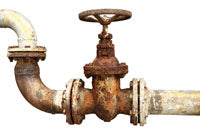Manganese and iron (especially the latter) produce problems to water appliances and increase the hardness of water. Many types of treatment are effective for the removal of iron and manganese from water, but not all methods are equally effective under all conditions.
Generally speaking, there are three basic methods to treat water containing these two contaminants. These are:

1) Ion exchange water softeners
- (a) Iron filters
- (b) Feed oxidizing agent and filter
- i) Chlorine or
- ii) Potassium permanganate (KmnO4): A dark purple crystalline solid, used as an oxidizing agent in a wide variety of processes. As a solid it is quite stable, and may be kept indefinitely if stored in a closed container in a cool dry area.
3) Sequestration*- use of such materials as polyphosphates**
- (a) "Pot" feeders>
- (b) Solution feeders
These methods are appropriate for use in treating waters that have an essentially neutral pH. For where waters are acid, the following is an especially useful technique:
- Oxidation and filtration
- Feed an oxidizing agent plus
Where waters are acid, the following methods of treatment are recommended: The use of an ion exchange softener is acceptable if the iron content is low and the water is not too acid. Larger amounts of iron and acidity call for the use of a solution feeding device and a filter.
One highly useful technique in the treatment of water with an alkali such as soda ash to raise the pH of the acid water and chlorine to precipitate the iron. With such treatment, a simple carbon filter can be used to remove the insoluble iron from the water.
When rusty water and staining persists in spite of adequate and proper treatment, it is likely that iron bacteria or corrosion are responsible. Even where the iron content of water is slight, iron bacteria can feed on the iron and store it in their sheaths. Further, iron bacteria may actually take iron from the steel pipe. Occasionally a bacterial slime accumulation breaks up to cause discharge of extremely turbid water.
The presence of iron bacteria can be determined microscopically. Also at times, slimy reddish-brown growths will be apparent in the flush tanks of water closets.
The following procedure is effective in killing iron bacteria already in the piping system. It may be used periodically if necessary, but is primarily recommended when steps have been taken to prevent further entry of the bacteria:
- Add approximately one-half gallon of sodium hypochlorite (household bleach) to the well. With some wells, it may be possible to add the liquid through the breather pipe. With others, it may be necessary to remove the good seal. Flush several gallons of water into the well to rinse the bleach down to the water level,
- One at a time, open each household tap, letting the water run until the odor of chlorine is apparent. Close that tap and repeat it with the next one. Do this until the entire plumbing system is filled with chlorinated water.
- After about 12 hours of contact time, the chlorinated water should be thoroughly flushed from the entire system. Considerable red water will be flushed out. Particular attention should be given to the flushing of the water heater, and draining of the heater is desirable.



